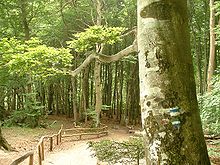Stubnitz
The Stubnitz is a hilly forest landscape of around 2400 hectares on the east coast of the Jasmund peninsula on the Baltic Sea island of Rügen . It stretches from the town of Sassnitz to the village of Lohme and is now almost completely part of the 3003 hectare Jasmund National Park . The name Stubnitz is probably of Slavic origin, but there are many different interpretations of terms in the literature - from stepland to forest with beehives.
flora
Between the 12th and 14th centuries, the common beech (Fagus sylvatica) prevailed in the Stubnitz due to the cool and humid climate , after mixed oak forests had dominated there for over 6000 years. In this Buchenwald today are isolated maple , yew , the service tree , mountain elm and various wild fruit species before, in wet terrain depressions and river valleys also ash , maple and alder . The proportion of non-native woody plants (e.g. conifers and poplars ) is only about 10%. The vegetation layer above the hundreds of meters thick chalk is very thin, especially on the higher areas . This is particularly evident at the edge of the high bank, but also where it has been damaged by human influences, for example at the edges of roads and paths.
Below the dense tree layer, only early bloomers have a chance in spring, which briefly splashes of color on the soil layer (white: wood sorrel , white anemone ; yellow: celandine , yellow anemone ; purple: violet , lark spur ). In summer woodruff , onion tooth root , brusque , wood fescue , and occasionally nest root can be found.
history
For centuries, the Stubnitz was subject to heavy forestry use in the form of coppice forest management . The otherwise almost forestless Rügen due to human land use was supplied there with construction and firewood and charcoal was produced in charcoal plants, which was sold all over the island and beyond. As a first measure against overexploitation , the paths leading into the Stubnitz were closed in 1551, except for four entrances secured by barriers (Rusewase, Buddenhagen, Hagen and Schwierenz), which were later provided with tree houses as accommodation for the forest counts. In 1586, a regulation issued by Duke Ernst Ludwig von Pomerania restricted logging.
In the period from 1648 to 1815, when Rügen was ruled by the Swedes, the Stubnitz was the Swedish crown forest. The aim was gentle forest management. Due to a royal decree, the Stubnitz was fenced in in 1731 . A forester and several wood guards now regulated the removal of wood, whereby the residents of Jasmund and Wittow were still entitled to certain amounts of free wood. However, a ban on forest-damaging hatching (except for goats) could not be enforced. In 1805 the Rügen historian and geographer Johann Jacob Grümbke (1771–1849) wrote the following in his book Streifzüge durch das Rügenland about the condition of the Stubnitz: “You can see that the forest is being cleared, and yet it is still attractive and very dense in some places. But I have seldom noticed tall, thick-trunked trees in it, most of them are young, of average stature, and the above-described rightful ax does not let them grow old ”.
After Rügen became Prussian in 1815, the royal forest administration succeeded in increasingly restricting or later even abolishing the old customary rights of forest pasture and the removal of free wood. In the middle of the 19th century, increased chalk mining began in the Stubnitz; For example, the wide gorge of the Kieler Bach was created by a chalk quarry that was in operation here until 1893. When it became known in 1926 that the chalk mining was to be resumed there, widespread protest was raised, which led to the fact that the permit for chalk mining was withdrawn.
natural reserve
In 1929 1,500 hectares of the 2,500 hectare forest area were placed under nature protection. In 1935 another protection ordinance was issued that declared the Stubnitz a nature reserve . On October 1, 1990, this protected area was supplemented by a 500 m wide coastal strip of the Baltic Sea and by the nature reserve created in 1986 around the Quoltitz chalk quarries and declared the Jasmund National Park. 60% of the forest area is near-natural and therefore designated as a core zone.
Individual evidence
- ↑ a b c d e Rügen National Park Office (ed.): The Stubnitz. The beech forest on the chalk coast. Lancken-Granitz 2001.
literature
- Indigena : Forays through the Rügenland. In letters. Johann Friedrich Hammerich, Altona 1805. Published by Albert Burkhardt. Brockhaus, Leipzig 1988. ISBN 3-325-00168-8
- Rügen National Park Office (ed.): The Stubnitz. The beech forest on the chalk coast. Rügen National Park Office, Lancken-Granitz 2001.
- Manfred Kutscher: The island of Rügen. Jasmund National Park. 2nd Edition. Association of Friends and Supporters of the Jasmund National Park V., Sassnitz 2002.
- Frank Biederstaedt: "... and when it is destroyed, the country is ruined." The checkered history of the Stubnitz on Rügen. Edition Pommern, Elmenhorst 2011. ISBN 3-939680-10-9
Web links
Coordinates: 54 ° 33 ′ 0 ″ N , 13 ° 38 ′ 0 ″ E

